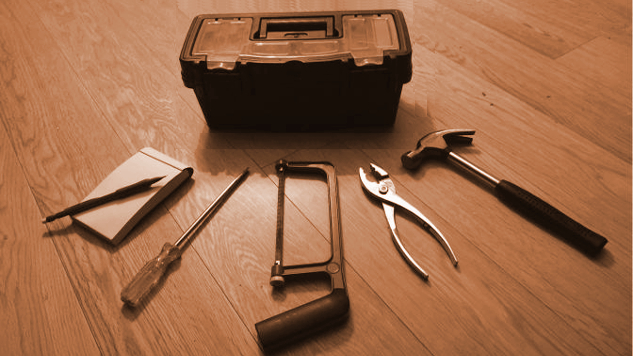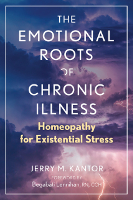
In Traditional Chinese Medicine’s Five Phase theory, a rudimentary psychological model is presented within which five basic emotions, each of which is aligned with a particular phase, are contained: joy aligns with Fire; anxiety (or worry) aligns with Earth, sadness (or grief) aligns with Metal, fear aligns with Water, and anger aligns with Wood.
It is the basis for a practical metaphor in my Inborn Toolkit of the Emotions. The point is made that when likening each basic emotion to a tool, an emotion’s expression serves the purpose of problem solving. After an issue has been resolved, as with a physical tool, the emotion can be put away, on reserve for a future problem. Dallying with or over-employing an emotion, similar to hanging onto an unused tool, serves no purpose (unless one is an actor). Similarly, refusal or reluctance to employ a needed tool or emotion impedes and complicates interpersonal transaction.
Five Emotional Tools in Your Kit
Imagine a tradesman with five tools in his kit. These are a sketchpad, a screwdriver, pliers, a hacksaw, and a hammer. Suppose he were to venture forth thinking, “Today I’m going to use only my screwdriver.” Or suppose he declares, “I hate my hammer. Today I’m just not going to use it.” This would be unlikely. A tradesman worth his salt respects all his tools, each of which he uses according to his needs, and each of which he places back in his toolkit when an allotted task is completed.
Proper utilization of an emotional tool is cathartic, meaning a satisfactory outcome is poised to result. Just as we are engineered with a pathogen-resisting immune system, so are we also from birth equipped with an emotional set of tools, each of which enables repair of a broken situation or renovation of a shabby state of affairs. Over- or underuse of any one emotional tool is bad workmanship, causing the framework of the psyche to wobble.
Before describing these tools, we note that our emotional tools can do a lot, but only within reason. Just as a standard toolkit might be used to build a shed in the backyard, we don’t expect to build a skyscraper with it. Similarly, trauma or abuse occurring in childhood, when our emotional tools are not yet fully honed, is challenging to overcome. Traumatic events debilitate our tools, damaging our ability to cope. Or, as in the phenomenon of denial, a tool can fall into disuse.
The Sketchpad of Joy
It is such a joy to view the big picture when the blueprint of a project is envisioned and everything is hanging together. We see it in its entirety. Now the time arrives when what exists on paper must be actualized. The glory of its vision must give way to the drudgery of execution. Dwelling forever in joy is not possible. An individual lost in visions or prone to excess of ego has not learned to put away his sketchpad. A homeopathic remedy known to upend this applecart is Sulphur.
The Sulphur individual is full of inadequately consolidated ideas. The individual is a kind of mad scientist, with a strong ego that hungers for approval. The Sulphur state can be compared to having an inefficient interior metabolic furnace. The Sulphur individual is always hungry, gassy, aggravated by heat, and prone to skin conditions erupting from the inner “furnace” source. A major remedy (or polycrest—a remedy that affects all or nearly all tissues of the body), Sulphur is one of homeopathy’s greatest contributions to medicine.
Symptoms arise in consequence of stress associated with luxuriating in one’s sketchpad, not putting it away, so that carrying out its wonderful ideas can be implemented. Instead, the Sulphur individually is stuck on a logically unanswerable question: How am I to be appreciated for my wonderful ideas when bountiful expression of my acuity is off-putting to others?
This question represents a subset of a bigger question: Is my presence in the world sustainable? There, instead of with the Fire phase, Sulphur is found positioned within the Earth phase.
Let us consider someone whose sketchpad is crumpled and jumbled within the toolbox. Disappointment and resentment has smudged the big picture, the overriding blessings of her life. Overwrought, depressed, and unclear as to where she is in life, a remedy such as Sepia is appropriate. Within Sepia a state of stagnation has taken hold relegating her to a limbo betwixt optimism and despair. Though invested in hope, she has experienced hope to be toxic, thus her psyche orchestrates a stagnation of metabolism and blood motility.
The Screwdriver of Anxiety
Imagine you are starving while lost in a wilderness and spy a mushroom. Eating it will either poison or nourish you. The screwdriver of anxiety tightens, heightening situational focus. Your hands sweat and your mouth goes dry as you lift the mushroom toward your mouth. But suddenly anxiety constrains the impulse. Elevated performance due to anxiety—here, eschewing a poisonous foodstuff or the partaking of a miniscule nibble—has saved your life.
Reluctance to use the screwdriver of anxiety stokes recklessness. A reckless individual can require a homeopathic remedy such as Medorrhinum. Medorrhinum is the nosode derived from gonorrhea and so the individual needing it infuses personal interests with passion and a tendency to go to extremes. The Medorrhinum individual has diminished use for the screwdriver of anxiety. The individual is prone to be a night person, is drawn to the ocean, may have familial heart disease, and can lose her train of thought mid-sentence.
Excessive use of the screwdriver of anxiety, on the other hand, is incapacitating. A homeopathic remedy to diminish excessive anxiety is Arsenicum album. Arsenicum album people are fastidious, perfectionistic, death obsessed, worried about anyone within their circle of love, concerned about aging, and prone to exhaustion.
The Hack Saw of Sadness (Or Grief)
The bond was strong between you and your beloved grandmother; now she is gone. Or, once solid, your five-year relationship with your partner is broken. Have you wept to a point of catharsis? Grieved the loss to completion so that you can move on? If not, the hacksaw of sadness (or grief) has yet to cut: Despite an appropriate interval’s passage, the bond is not severed and grief remains locked in place. You are sad but unable to cry. This calls for the homeopathic remedy Natrum muriaticum, made from sodium chloride.
Natrum muriaticum individuals are self-contained. Compare them to a country that sends all its resources to the periphery. The impression given of studied calm and self-reliance disguises a tenderness of feeling and vulnerability sequestered in the interior. Such a person will cry only in private, be averse to consolation, crave intimacy but keep it at arm’s length. Recourse to the hacksaw expresses the unthinkable: If I cry it would be forever. To complete my grief for this loss would be to dishonor its magnitude.
Overuse of the hacksaw of sadness, on the other hand, suggests the remedy Pulsatilla nigricans for someone who cries at the drop of a hat. No matter how fervently the loss is sawed away at, the blade fails to cut through and sever it. Never-unpacked baggage, longstanding or subconscious memory of having been previously abandoned, makes the effort futile. The Pulsatilla nigricans individual is often a stereotypically “hormonal” woman, or if a boy, seldom older than the age of twelve. The individual has a soft temperament. Your heart goes out to this person.
The Pliers of Fear
Idioms reliably express the truth. As an example, it is said that fear grips us. As if clasped by pliers, we freeze before taking action. The pliers of fear allow grasping of the situation and enabling an expeditious choice between fighting and fleeing. When the pliers of fear do not lessen their grip, a routine non-threatening situation can escalate to life-or-death proportions. This may call for the homeopathic remedy Veratrum album.
A Veratrum album individual overuses the pliers of fear due to having in the past experienced a sudden loss of social position. Some shocking event has pulled the rug out from under this person and left a feeling of having been abruptly evicted from Paradise. By way of compensation the individual becomes self-righteous. “So lost, only they know the way,” describes this peculiar conundrum, a state featuring weakness, sudden vomiting, cold sweat, collapse, and distorted perception. The abrupt onset of weakness in the remedy picture serves to reenact the precipitating “the rug was pulled out from under me” trauma.
On the other hand, someone in whom fear has inculcated an escapism reaction may become audacious and insensitive to pain. Incapable of finding coping pliers, this individual needs homeopathic Opium. The lack of reactivity within an Opium state features constipation, deep sleep with intense dreaming and snoring, and a feeling of inner tremor.
The Hammer of Anger
A situation arises requiring immediate and forceful action. Insulted or frustrated, the individual pulls out the hammer of anger and smashes down. Better, but in the same spirit, this force is directed into a creative action. The individual failing to do so fears that natural expression of anger will go badly and culminate in loss of control or violence, so indignation is suppressed.
When the individual needing the remedy Staphysagria flies into rageful passion, it is frustrated displacement rather than a cathartic anger that is vented. Such an individual will likely throw an object, slam a door, or weep in frustration, wielding the hammer but using the incorrect end of the tool to claw out a crooked nail. This is anger’s dysfunctional cousin, vexation, a state featuring repression and trembling with frustration. Overinvested in honor, in the wake of genuine anger, the Staphysagria individual would feel worse, not better, which is why the emotion of anger is suppressed in the first place.
Due to social conditioning, women are often brought up to “be nice.” Women, therefore, tend to require Staphysagria more often than men. However a male may occasionally need this remedy.
The Staphysagria state’s investment in honor and not utilizing the hammer of anger reflects or promotes injury to an individual’s integrity. Harmed inner integrity promotes weakness of the teeth and subsequent tooth decay. The teeth are the one place in the body that our bones are visible. Everything “hangs” on the skeletal structuring of our bones. They are the physical embodiment of our integrity.
Someone can become enamored of, and overuse, the hammer of anger. The individual with a hair-trigger temper who is instantly provoked into rage will need a remedy such as Stramonium. Here we find a classical post-traumatic stress disorder (PTSD) prescription for the freshly returned veteran from military combat. Such persons are plagued by nightmares of violence, prone to religious beseeching, fear the dark, and are excited by the stimuli of glittering objects. Likewise children who have witnessed terrifying violence and become prone to rage and violent tantrums—a survival response countering fear of abandonment or impending annihilation—will benefit from this remedy.
Emotional Tools and Homeopathic Remedies
Therapeutic recourse to emotional tools is easy to recommend; seeing that the directive is carried out is another matter. This is because emotions we employ while coping are not consciously accessed. Our reactions—individualized “default” response patterns—release automatically from the subconscious. Even when clearly self-sabotaging, dysfunctional response patterns are difficult to rework and routinely defeat the finest therapists.
On the other hand, because it operates behind the scenes, as it were, the directive of a well-chosen remedy is not easily ignored. The remedy is like a bomb deposited within the subconscious, one that after its explosion, the dust having settled and the air cleared, leaves a transformed inner terrain. With the psychic landscape altered, interest in the inborn toolkit’s possibilities is refreshed.
Copyright 2023. All Rights Reserved.
Adapted with permission of the publisher,
Healing Arts Press, an imprint of Inner Traditions Intl.
Article Source:
BOOK:The Emotional Roots of Chronic Illness
The Emotional Roots of Chronic Illness: Homeopathy for Existential Stress
by Jerry M. Kantor
 Jerry M. Kantor presents diagnostic insight, specific homeopathic remedies, and successful case studies about the profound connections between emotions and their physical manifestations in illness. He further correlates the five classical miasms and their core existential quandaries with the Five Elements and Phase Theory of Traditional Chinese Medicine (TCM). He likens inborn foundational emotions to tools, each one designed to solve a stress-related problem. Self-sabotaging imbalances occur when an emotional tool is excessively used.
Jerry M. Kantor presents diagnostic insight, specific homeopathic remedies, and successful case studies about the profound connections between emotions and their physical manifestations in illness. He further correlates the five classical miasms and their core existential quandaries with the Five Elements and Phase Theory of Traditional Chinese Medicine (TCM). He likens inborn foundational emotions to tools, each one designed to solve a stress-related problem. Self-sabotaging imbalances occur when an emotional tool is excessively used.
Revealing that the subconscious mind is amenable to change, Jerry shows how to accurately select remedies to defuse the energetic charge of unresolved existential stress and thus quell the root causes of chronic illness.
For more info and/or to order this book, click here. Also available as a Kindle edition.
About the Author
 Jerry M. Kantor, L.Ac., CCH, MMHS, is a faculty member of the Ontario College of Homeopathic Medicine and owner of Vital Force Health Care LLC, a Boston-area homeopathy and acupuncture practice. The first acupuncturist to receive an academic appointment at Harvard Medical School’s Department of Anaesthesiology, Jerry Kantor is the author of Interpreting Chronic Illness, The Toxic Relationship Cure, and Autism Reversal Toolbox.
Jerry M. Kantor, L.Ac., CCH, MMHS, is a faculty member of the Ontario College of Homeopathic Medicine and owner of Vital Force Health Care LLC, a Boston-area homeopathy and acupuncture practice. The first acupuncturist to receive an academic appointment at Harvard Medical School’s Department of Anaesthesiology, Jerry Kantor is the author of Interpreting Chronic Illness, The Toxic Relationship Cure, and Autism Reversal Toolbox.
Visit his website at VitalForceHealthCare.com/























